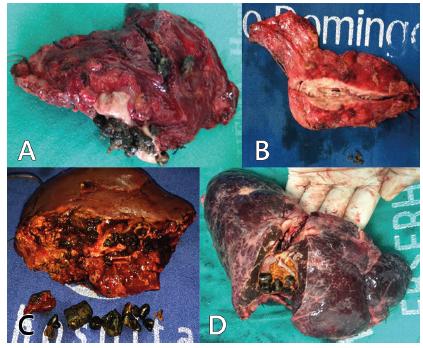ABSTRACT
Background:
Primary intrahepatic lithiasis is defined when the stones are formed in the liver and associated with local dilatation and biliary stricture. Liver resection is the ideal procedure.
Aim:
To evaluate the results of liver resection in the treatment of non-oriental intrahepatic lithiasis.
Methods:
Fifty-one patients with symptomatic benign non-oriental hepatolithiasis underwent surgical resection in six institutions in Brazil. Demography data, clinical symptoms, classification, diagnosis, management and postoperative course were analyzed.
Results:
Of the 51 patients, 28 were male (54.9%), with a mean age of 49.3 years. History of cholangitis was observed in 15 (29.4%). The types of intrahepatic lithiasis were type I in 39 (76.5%) and type IIb in 12 (23.5%), with additional type Ea in six (11.8%). Liver function test were normal in 42 patients (82.4%). Segmental atrophy was observed in 12 (23.5%). Treatments included left lateral sectionectomy in 24 (47.1%), left hepatectomy in 14 (27.5%) and right hepatectomy in eight (15.7%), with associated hepaticojejunostomy in four (7.8%). Laparoscopic liver resection was performed in eight (15.7%). Postoperative complications were observed in 20 (39.2%) with no mortality.
Conclusion:
Liver resection in patients with hepatolithiasis is the ideal procedure as it removes stones, stricture, atrophic parenchyma, and minimizes the risk of cholangiocarcinoma.
HEADINGS:
Hepatolithiasis; intrahepatic lithiasis; Non-oriental; Liver resection; Hepatectomy



